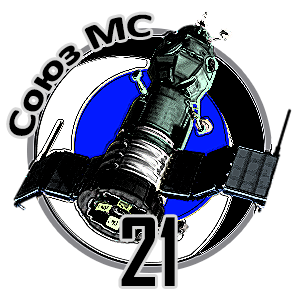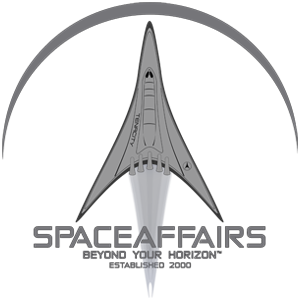
Commanders MIG-25 Flight
To the Edge of Space
by Andreas P. Bergweiler (D) March 2004
High Above – That's, what are dreams made of!
From the Captain’s LogPrologue
Once upon a time, there was a demon who lived in the air. It was said that anyone who ever challenged him had to die. They told themselves that the control instruments would block, the planes would swirl around violently and finally be smashed to pieces.
The demon lived at Mach* 1 on the Mach-Meter. That means about 1,200 kilometres per hour. Where the air can no longer escape.
He lived behind a wall which was said not to be penetrated by anyone. They called it: The sound barrier. [Tom Wolfe: The Right Stuff]
Many decades had passed since 1947 when Chuck Yeager broke the sound barrier with the legendary Bell X-1. Since then, one-speed record after another has been broken. Many courageous men sat down in newly developed machines whose technology was so new that some had just come out of the test stand and still had the smell of the factory hall. No one could know whether the machines would withstand the tremendous forces to challenge the 'Demon' and find out what was behind the legendary 'Sound Barrier'. Nobody knew if a human was up to these powers.
Manned space travel would not exist without the test pilots who hunted the demon. It was the young men of the American Air Force and the Russian Air Force who set out in the late 1950s and early 1960s to become the harbingers of mankind's first "star travellers".
The first person who dared to ride a rocket into space was Yuri Gagarin (April 12, 1961), himself a test pilot and an experienced pilot. Every astronaut or cosmonaut must know what it means to "fly" before he breaks into space on a jet of fire. Loads of a flight with a jet are partly higher nature than to fly on the top of a Soyuz rocket or in a space shuttle.
In March 2004 I had the opportunity to experience on my own body and in real life what such a flight to the limits of endurance means. On the morning of 10 March 2004, I set off for Star City to look for this demon and experience for myself what the pilots had been through at the beginning of the supersonic flights...
The Mach number (named after the Austrian physicist-philosopher Ernst Mach, 1838 - 1916), in short Mach. The physical unit of velocity without unit symbol with formula symbol 'Ma' indicates the ratio of the velocity v of a body to the velocity of sound cS in the surrounding medium. It applies:
Ma = frac{v}{c_S}
In aviation, Mach is mainly used to indicate the speed of fast flying aircraft. The rising Mach number Ma is the ratio of the flying speed to the speed of sound in the air. It is an essential measure of the compressibility of the air. At Ma = 1 (Mach One) the sound barrier is broken. Under normal environmental conditions, the speed of sound corresponds to a rate of about 1,220 km/h. The speed of sound is determined by the speed of sound. The same 1,220 km/h in the stratosphere, a layer around the earth that starts at about 10-18 km depending on the latitude and reaches up to a height of about 30 km, corresponds to a speed of Mach 1.16. In the stratosphere, the rate of the sound barrier is about 1,220 km/h. In the stratosphere, the speed of the sound barrier is about 1,220 km/h.
Preparations
Weeks before the confirmed flight I deal with the topic "supersonic flights and effects". I searched the internet for information and absorbed things inside me, tried to get some things into my head that showed up on the monitor. Terms like "G-force" and "tunnel effect" were not alien to me. Should I now also encounter these effects, or was today's technology so extensive that this flight with a MIG 25 'Foxbat' should pass with a lightness and the trip would be represented by it, only the experience of the sight of the earth from great height made possible? A few ordinary mortals, i.e. neither test pilots nor pilots, had already completed such flights. I saw films on the Internet and read their testimonials. I thanked the inventor of the Internet who, after a short research, was able to have the necessary data on the screen today. Unimaginably still some years ago, the knowledge of mankind spread under me to the topic "flying".
Only a few years ago I would never have dared to dream of sitting in a machine myself and chasing away towards the sky. At night I dreamed of flying and the idea developed in my head that this dream would soon become a reality, and so the days passed at the beginning of the year. At the beginning of February, the story was told a bit more in the acquaintance and family circle that I wanted to set off to make the sky over Russia uncertain with the MIG 25, and it quickly became clear that I would not go on this journey alone. I got to know Fabrice Schmidt, managing director of mydays in Frankfurt and understood him very quickly. Without him, this full borderline experience would not have been possible.
It quickly became clear that a television team from Janus TV in Munich would be there to plan a new production for PRO 7 and record this flight on video. I got to know Attila Teri, and his first words were: "Man, what am I stressed out about!“ We talked for a long time about the upcoming flight, and he sent me video footage of reports he had shot in the years before for different formats of the PRO 7 group. A video attracted my increased attention: Boom Operators.
Hmm, have you never heard of it? But you probably know the fact that airplanes in the sky can be refuelled by other tankers. And Attila had captured this refueling on video, in the first team of non-Americans on board US aircraft. He and his team could film this refuelling with all things. A "boom operator" is the man in the back of the tanker who controls the 'trunk' and carries out the refueling of the other aircraft. He lies on his stomach and looks out of a window, under and behind the tanker the other airplanes race. When I saw these pictures, I knew that I was lucky, and that Attila was just the right person to capture this topic of an 'Edge of Space Flight´s' on video.
I kept these pictures in my head and absorbed more information about what I could find regarding jet flying. I watched a lot of flight videos to get a feel for this flight. Among other things also a training video of the US Navy's aerobatic squadron, the 'Blue Angels'. When I saw these hair-raising aerobatic manoeuvres, my breath stopped, and I was glad that I should 'only' go on a 'High Altitude Flight' that could not be compared to aerobatics. You can imagine that I was wrong with this assumption.
And so, the day of the departure came closer and closer, and I feverishly awaited the flight. Now ask me what I felt, I can't give you an exact answer, but I'll get to this "feeling" later.
On the way to Star City again
At noon on 10 March, I met Fabrice personally for the first time before the Aeroflot check-in counter at Frankfurt Airport. We had already phoned dozens of times before and now we were facing each other. If you had spoken to a person often, you already know him quite well, and we understood each other just as well as we did on the phone. When two hours later we sat next to each other in a Boeing 737-200 and headed east, we talked a lot about visions, especially about my vision to be able to fly to the stars. Fabrice had only founded his company mydays in December 2003 and had a lot of ideas.
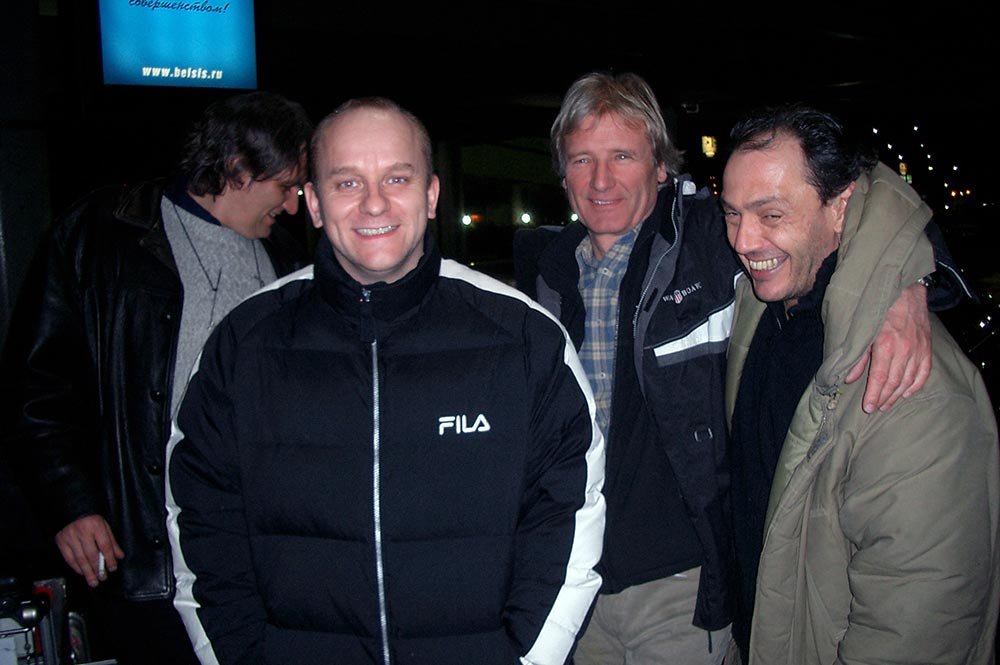 Floh, Andi, Hansi & Atti - Sheremetjovo - March 2004
Floh, Andi, Hansi & Atti - Sheremetjovo - March 2004The film team from Munich - consisting of Attila Teri, the cameraman Johann Goldfuß-Falke and his assistant for light, camera and sound Florian Ruppert - had already started one hour before us from Munich. In their luggage, they had lots of equipment for filming my MIG-25 flight, and I hoped for them that they wouldn't have any problems at Russian customs.
After three hours of flight, the captain of the Boeing 737 put the plane on the airport Sheremetyevo 2 in Moscow, which I now know very well. Half an hour later we stood at the entry formalities. These take a little longer until the officials have checked the passports and visas. I have already experienced that nothing was going on, that evening it was mediocre. After this thing was done and I was again in possession of my luggage, a perfect acquaintance approached me and grinned at me: Igor Rudyaev from the GCTC, old friend and companion, smiled at me, waved and said to me: "The Film Team. They have problems!“
Our fears had come true. The Russian customs officers lovingly eyed the various boxes of the film team and so a waiting period was inevitable. After Fabrice and I had passed through customs, I looked for Igor's friend and Sergei's right hand. He should be standing somewhere in front of the door. After an unsuccessful search, I came back to the hall and see there: against the payment of an amount of 400 euros for the equipment of the film team all problems of the Russian customs had been repaired. So, it went so fast, and Fabrice and I greeted the team. A somewhat 'annoyed' but exuberant three-man group joined us - Attila, Johann (called Hansi) and Florian (called Flo) were greeted.
After the bus had been located and our luggage and equipment stowed away, we set off towards Star City, and I realised what it means to say, 'Russian Winter'. The roads were all clear, but you could see meter-high snow drifts left and right of the streets and highways, caused by snow ploughs that had eaten their way through the snow-covered roads in the last days.
The team drove in the bus, I with Igor. Sometimes the bus was faster, sometimes we were, and it began to realise in my head that there were only a few hours left before I would face my big challenge. With all the adventures, the Sea Survival for Cosmonauts, parabolic flight and centrifuge test I realised for the first time in this minute with Igor in the car that I had probably the most exciting encounter in front of me: The flight with a MIG 25 with Mach 3 in more than 25 kilometres altitude. I thought about it in the dark, but Igor quickly involved me in a conversation, and my flight became the background of my thoughts.
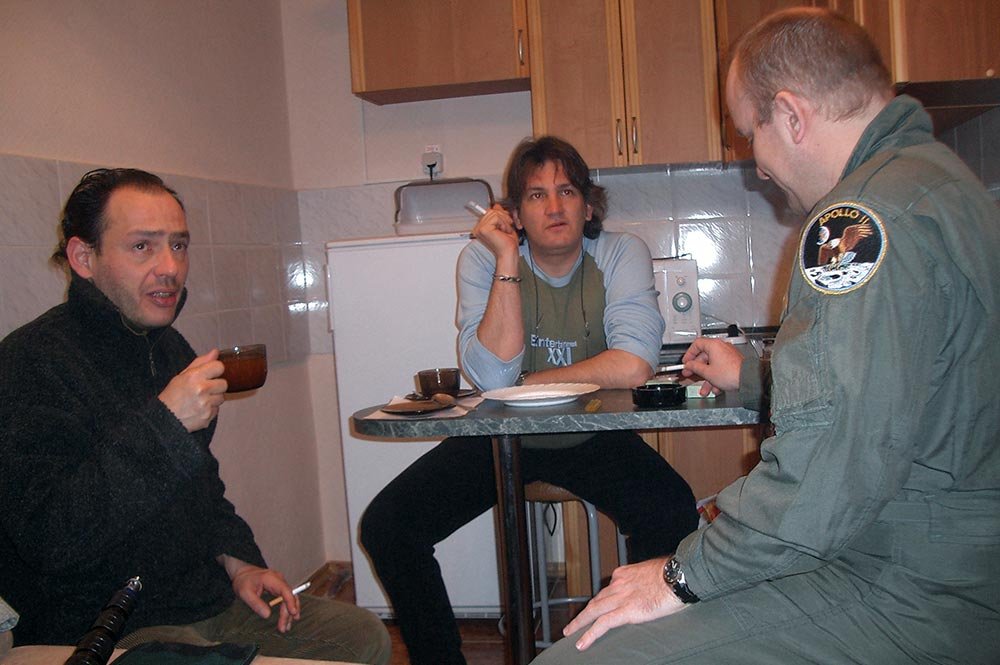 Attila doesn't look good - Star City - March 2004
Attila doesn't look good - Star City - March 2004After an hour we drove through the forest around Star City, which I already knew very well, and we drove into the city. Here the term winter was even more present than in Moscow, meter-high snow barricades to the left and right of the streets showed that the Russian word for winter storm 'Buran' was here probably meaningful. Quickly our luggage and the film equipment were stowed away in the Profilaktorium, a 'Cosmonaut Guest House'. Here the international crews live before a start or during their training, or also after their space flight, to recover. By Western standards, you can feel very comfortable here. In September last year, we lived in the Profilaktorium. At that time, I had got to know the parabolic flight, which means weightlessness.
One hour later we found ourselves in the large communal kitchen having a typical Russian dinner and Igor prepared us for the next day. We had a briefing and a schedule, and it was clear that the next day would start very early. Around 1 o'clock we broke up the usual round (in which of course the Russian Vodka played a role) because the alarm would ring the next morning at 6 o'clock. So, I had another 10 hours until I would meet the demon I had heard about from pilots. The flight was scheduled for 11 a.m., and I fell asleep very quickly. In my dream, I was already flying around, but reality would have caught up with me soon.
T minus 5 hours
After I had a refreshing shower the next morning shortly after 6 and put on my flight dress, I noticed the first real tension. I thought about whether I could stand the strain during the flight. Pictures of the film 'The Right Stuff' came to my mind. But I discarded the images and tried to prepare for the day. I felt, and sometimes I didn't even feel as if I had one of the most exciting adventures in front of me, of which many only dreams.
The first problem of the day was not long in coming: Attila was ill. He had a fever of almost 40 degrees and looked as if he would tip over at any moment. We sat in the flea's room and drank coffee and tried to spice Attila up with aspirin and Co. again. It wasn't so great for him, he had to be there for the shoot. He was the author, he had his story in his head, which I knew only fragmentarily. Sergei, Igor's right hand was involved, and he phoned briefly to get 'anti-flu' from his wife. Then the boxes were packed, and we loaded the bus. Around 8 o'clock we started moving and left Star City.
The winter landscape captivated me now. The evening before everything was dark, now you could see the actual dimensions of the 'Buran': Meter-high snow layers piled up beside the streets, and the people, no matter what kind of work they were doing, waited for the bus or went to work. 5,000 people live in Star City, and each of them has a role to play in Russia's space program. An ordinary worker earns 90 euros a month on average, unimaginable for a Central European. A Russian cosmonaut wins about 450 dollars a month, depending on how many flights he has had it can be a little more, but hardly anyone earns more than 600 dollars. The cost of living in Star City, however, is adjusted to the salaries and, in contrast to Moscow, really cheap.
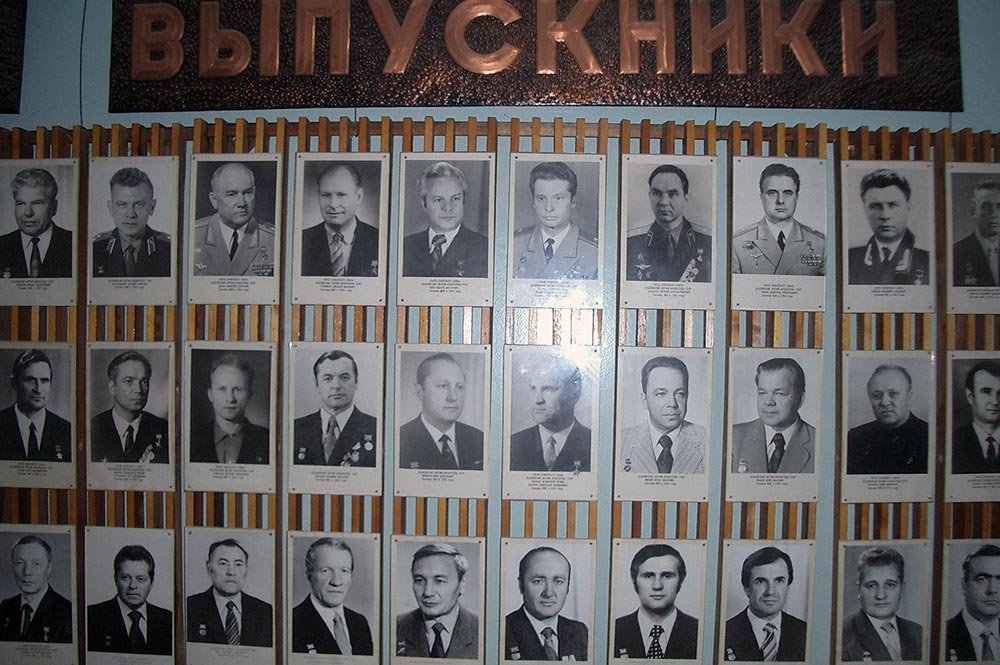 A lot of history at the airbase - Ramenskoye - März 2004
A lot of history at the airbase - Ramenskoye - März 2004The bus ride proved to be survival training. Our way led from Star City in the direction of Moscow. During the trip, I talked to the team about all sorts of things, and in the suburbs of Moscow, the typical Stalinist prefabricated buildings passed me by. The ride seemed to be endless, and from time to time I also nodded off on my seat. Three hours to the demon, I thought.
After two hours by bus, we reached our destination, the Ramenskoye base. Here some air force regiments of the Russian Federation are stationed as well as the 'Fighter-School of Russia', comparable to 'Top Gun' in the USA. We had to wait, and again half an hour passed by. It had become half-past eleven by now, and my demon answered me: "Within the next few hours we'll meet, Andreas."
Valeria, our guide for the base reached us, and after a short check at the guard we could pass the gate and drove on ice floes. I felt more like I was in Antarctica. Centimetre-high ice sheets had melted together on the roads inside the base, and our bus limped over them, slipped and wobbled. We stopped in front of a building. I hardly had time to inspect my new surroundings, when Johann came and said that from now on his camera would accompany me everywhere. So, the film had to be started. Everything at the beginning! Quiet, please! Camera on! Sound on! Scene 1 the first: Bergweiler entered the 'Fighter School of Russia'.
Med-CheckUp and Briefing
First, we had to find our way around the building. First with some elevators and stairs to other floors, our guide Valeria led the troop. Here lived and worked the top pilots of Russia.
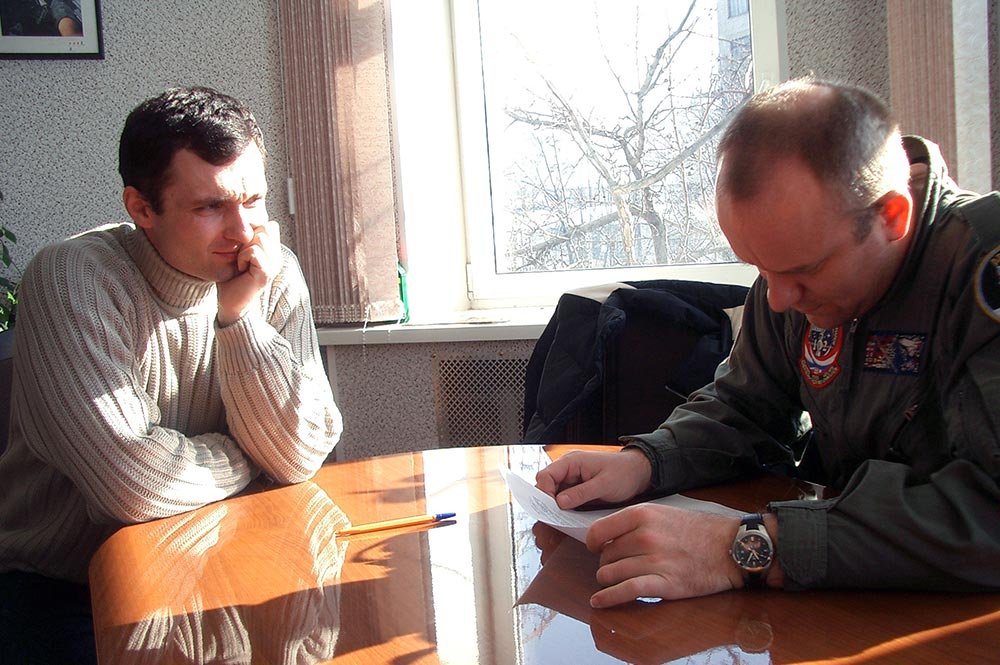 Sascha during his briefing - Ramenskoye - March 2004
Sascha during his briefing - Ramenskoye - March 2004We stopped in front of a door, and Valeria said that the medical check-up would take place behind this door. We entered, and a small, older doctor greeted us very friendly and pointed me to a seat next to her desk. She spoke English quite well, and I presented her with my medical certificate which I had brought from Germany. She flew over it briefly and pushed a questionnaire over my desk. I knowingly answered every question about illnesses etc., then she measured my pulse and my blood pressure. The blood pressure was slightly higher, but this was not due to the expectation of the MIG 25. This was instead because Johann had chosen all possible places where he worked with his camera. He made me a little nervous, as did the doctor, she said that this was not a theatre, but a must-see. She was distraught that Johann was kneeling behind her desk with his vast Digi-Beta-Cam to film me while she was examining me.
So, we made a film first, and then the medical examination followed, and rightly so. Listening to the lungs, blood pressure, visual acuity, etc. I already knew enough about these medical examinations, and again I found out that I was actually in pretty good shape, without anybody noticing.
After the medical examination, another room followed, here the briefing would take place. After 20 minutes my pilot appeared.
Alexandre V. Pavlov, called 'Sasha' entered the room and joined us at the table. He introduced himself briefly and then discussed the flight route with me and asked me some questions. For example, if I had ever flown in a jet. I could answer this question with 'yes', I had once sat in a tornado of the German Armed Forces as a 'KBO' behind the pilot when he did some rounds in Büchel (Eifel). However, this flight was not comparable with what I was about to do.
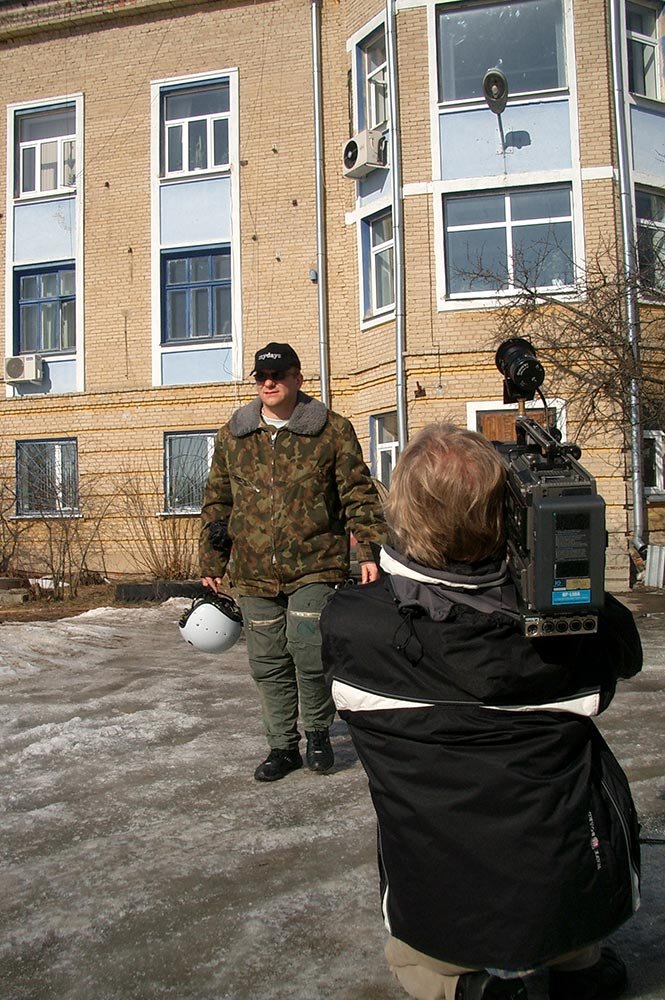 Feeling like on a catwalk - Ramenskoye - March 2004
Feeling like on a catwalk - Ramenskoye - March 2004Sasha is the son of a test pilot. After finishing school, he decided to become a pilot and went to the 'Kharkov Higher Military Aviation School for Fighter Pilots', comparable to 'Top Gun' in the USA. When he passed the exams in 1990 with many awards, he received his pilot-engineer diploma. He then served as a fighter pilot for the Russian Air Force until 1992. After this time, he left the military and changed to the Ministry of Aviation Industry, there to the Test Pilot School. Since then he has been an experimental test pilot at the Gromov Flight Institute. His flight experience amounts to over 4,500 flight hours (approx. 6,000 flights) in more than 20 different types of aircraft. He often takes part in flight demonstrations and in his private life he is an enthusiastic mountain skier.
He told me all this during his briefing, and he explained to me on a map the route we would be flying and some technical aspects of the Edge of Space Flight, as it is called by space enthusiasts. He said we were flying at 25,000 meters, but the weather looked so good that it was possible that we could climb even higher. I laughed and told him, "Okay, if you think you can take me to the ISS, do that!“
He laughed and made it clear to me that this flight would be an excellent challenge for a pilot. There are only 5 pilots in Russia who made these high-altitude flights and had experience with them. Many aspects have to be considered during such a flight: Temperature, technical condition of the aircraft, speed, state of health of the pilot, etc. After he had briefed me, he presented me with a letter which I would have to read through and then sign. No signature, no flight.
I knew what I would sign. The release of liability declaration for the 'case of the cases'. It is clear that if you were to take part in such a flight as an ordinary citizen, the military, as the owner of the aircraft, naturally assumed no liability whatsoever. Anyone planning such adventures must be aware that they are doing so at their own risk. It has been clear to me for years that no insurance in the world would cover you (perhaps once Lloyds in England against horrendous payments). So, I signed, and the next step was done.
Sasha grinned and said, "Okay. Now you will go to the dressing room, we will see us again at the MIG 25." He pressed my hand briefly and then disappeared almost silently from the room. He had charisma, definitely, and I felt entirely safe. So, I followed Valeria to the next room.
Dress Man
Two women appeared with a friendly laugh on their face, and I had to strip in front of their eyes, except for their underpants. I was given blue underwear, which proved to be fireproof on demand. Similar to the underwear of Michael Schumacher. Then came the G-Flight-Suit.
The G-Flight-Suit is a special suit with integrated air chambers whose connections are connected to the cockpit of the jet. It prevents the blood from sinking into the lower and upper extremities during the stresses and strains that occur during high-speed cornering flights and other manoeuvres. If this suit weren't on board, I wouldn't be so well, the G-forces would push the blood into the legs, and the brain would get a lack of oxygen. A blackout would be the result, not the right conditions to complete such a flight. The G-Suit is very tight and has many cords and buckles.
After 10 minutes it was professionally put on, and I got my flight overall. Unfortunately, I couldn't use my own because it has no opening on the left side at hip height to connect the hoses of the G-Suit with the cockpit. Afterwards, the helmet was adapted, and the oxygen mask was checked, as well as the radio.
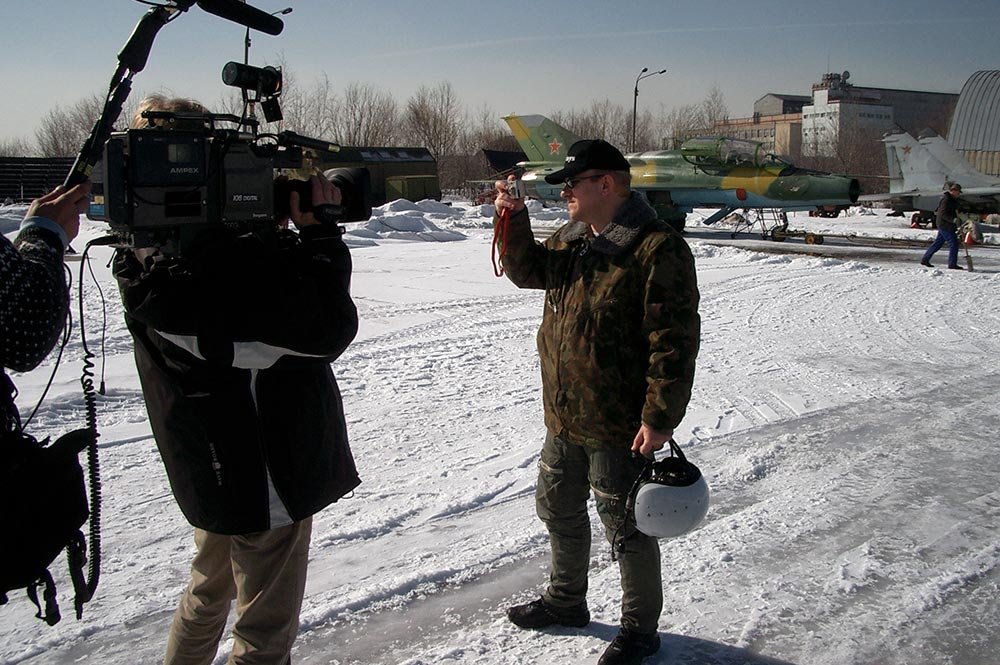 Camera on, sound too - Ramenskoye - March 2004
Camera on, sound too - Ramenskoye - March 2004I felt reminded of my adventure in Sochi at the Black Sea. Putting on a Sokol pressure suit for cosmonauts was much more exhausting and time-consuming. But similar. When I sat in front of the mirror and was introduced to the secrets of the helmet and the oxygen mask, reality crept up on me for the first time: Andreas, you will reach the highest heights that can be achieved with a jet. The MIG 25 holds the altitude record for non-rocket-powered aircraft with an altitude of 37,800 meters. This record has been unbroken since 1977.
When I thought about it, Chuck Yeager came back to my mind when he drove the prototype of the 'Starfighter F-104' into undreamt-of heights in the middle of the 60s, when the first Mercury and Soyuz spaceships had already penetrated orbit several times. The plane had reached almost 100,000 feet, but at that altitude, the engine failed, and Yeager's flight almost ended in a catastrophe, only the ejection seat could save it.
After also the briefing in the suit and the technology of the flying helmet was finished, I was given a thick thermal jacket in camouflage colours and gloves. Then the two girls patted me on the shoulder and said in very broken English: "Now, you are ready for flight!“ I stood in front of a mirror and was just amazed. There I stood, thickly packed in four layers and grinned at my reflection. It grinned back and said: "You didn't choose it any other way!
I felt the suit on my body. Indeed, not a cosmonaut suit, but very cuddly. I also had the feeling that he had a very supporting effect on the spine, no wonder, he protected me not only against a lack of blood supply but also against the physical forces that were supposed to affect me during the flight.
The helmet was very tight, from the outside not much of the voices and the noises sounded to my ears. Indeed, also a sign that it would become deafening on board the MIG-25.
A close encounter with a Russian lady
In the hallway, the film team put me through my paces again. At least I've had some privacy while I'm moving. Johann gave me the next 10 or 15 minutes of instructions, I had to climb stairs, take the elevator and walk dozens of times through the front door until he was satisfied.
I reminded the TV team again this time that they were professionals. And professionals demand professionalism, even from a 'non-actor'.
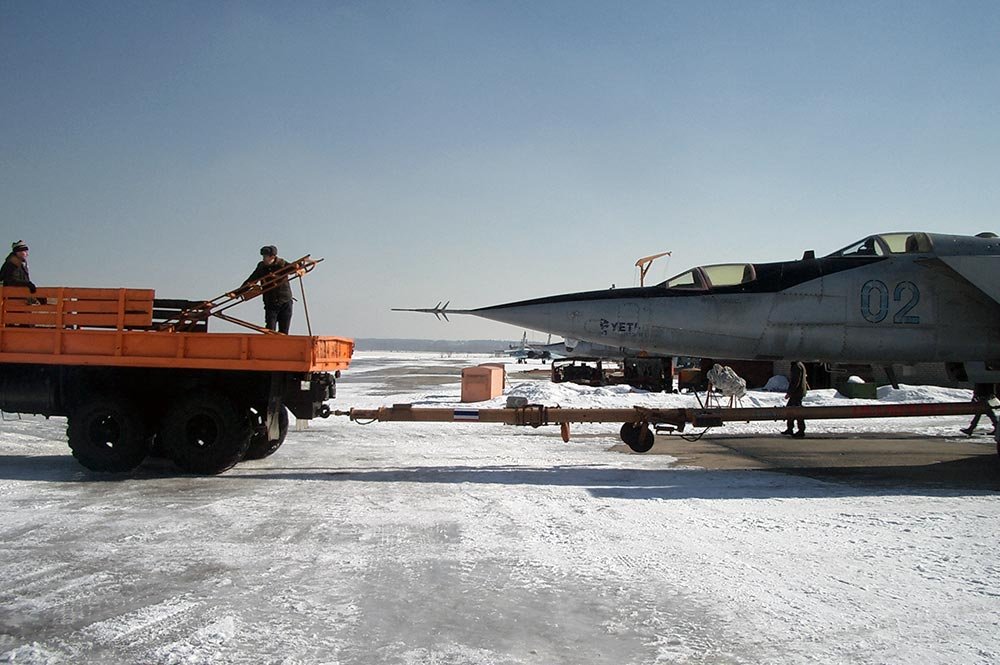 The MIG-25 is pulled out of its hangar - Ramenskoye - March 2004
The MIG-25 is pulled out of its hangar - Ramenskoye - March 2004In a bumpy ride over 'ice floes,' we continued, and the bus drove with all of us to the airfield. We drove past bombers, which I only knew from the internet or from my time with the Bundeswehr. I remembered the posters of large posters hanging on the blackboards in the barracks. TU-27 bombers, many combat helicopters and types of aircraft that I had never seen before in my life stood at the airport.
After 10 minutes of bumpy driving, we came to a standstill, and I saw through the windows the aircraft hangars. These famous hangars at military airports, under which the fighter jets hid. A truck was standing in front of a hangar, and the tow bar of the truck disappeared into it. I suspected that the MIG was probably at the end of this tow bar and I got off the bus and went further forward. The TV team took all kinds of pictures, and I waited until the truck started to move.
And then I saw the MIG 25, which until then I only recognised from photos in reality. To be honest, I had to hold my breath a bit because I didn't think it would be that big. The truck drove until the MIG 25 was entirely out of the hangar and then stopped. I stood stiff in the snow, and it was as if absolute silence was coming. The hustle and bustle of the ground crew and my team disappeared within seconds. I let this grey monster have an effect on me. I didn't forget that it was a weapon in the end. Built as a reconnaissance plane and as an observation plane. This one was not armed, but you could see under the wings the devices where the weapons could be mounted.
For technology enthusiasts here something more exact to the MIG 25:
MIKOYAN MIG-25 NATO code: Foxbat.
The MIG 25 was designed as an all-weather aircraft that should clear all targets under all conditions. Day and night, it was used in the Soviet and later in the Russian Air Force. It was exported to Ukraine, Kazakhstan, Azerbaijan, India, Iraq, Algeria, Syria and Libya. Some were also transferred to the air force of the GDR so that after the fall of the wall the air force of the Federal Republic of Germany came into the possession of 12 airworthy MIG 25. However, these were not officially put into service, but sold.
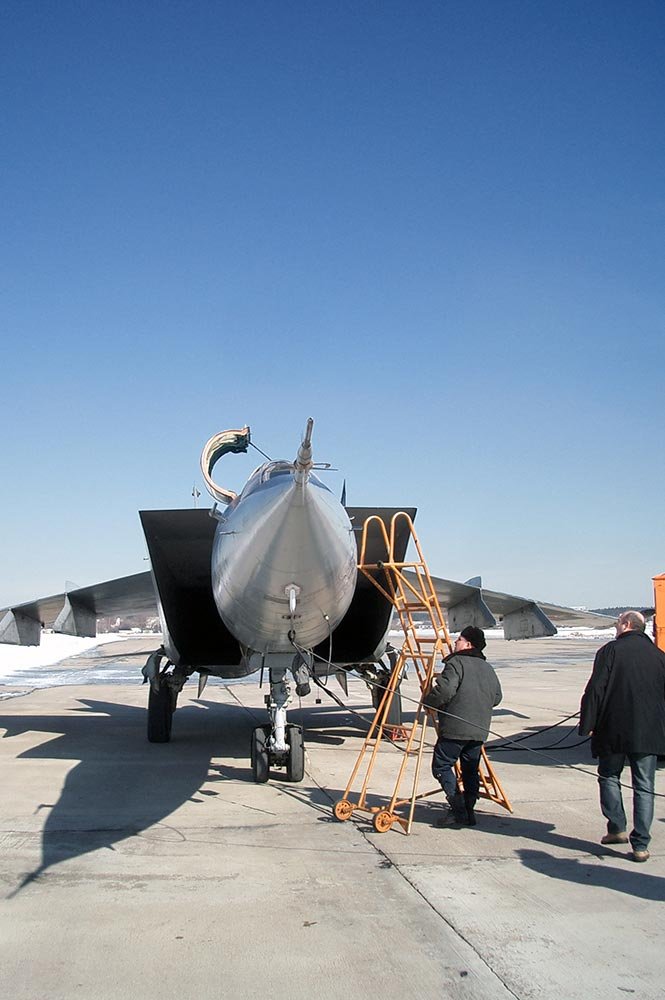 The MIG-25, NATO Code "Foxbat" - Ramenskoye - March 2004
The MIG-25, NATO Code "Foxbat" - Ramenskoye - March 2004The first constructions go back to the year 1959. Planned as a counterweight to the American 'SR-71A Blackbird', a high-flying reconnaissance aircraft of the United States, which could penetrate into great heights to obtain spy shots of the enemy territory. The development phase was completed in 1962 and further modified after these years. The first prototype flew on September 9, 1964, and then served in all countries of the Warsaw Pact. In the late 80s and early 90s, the MIG-25 was replaced by the MIG-31.
Powered by two Soyuz/Tumansky R-15BD-300 turbojet engines. Thrust 86.30 kN in normal flight, 109.75 kN with afterburner. Fuel tanks (70%) in the main fuselage between cockpit and jet system, one tank in each wing with a total capacity of 17,660 litres.
Maximum speed: Mach 3.2 (3,600 km/h), maximum speed above sea level 1,200 km/h. It takes 8 minutes and 55 seconds to reach an altitude of approx. 22,000 metres (approx. 66,000 feet). The service ceiling was normally 22,686 metres (67,915 feet). The range (full tank) is 1,730 km with a full load, flight time (without additional tanks or air refuelling) 2 hours and 5 minutes.
Wingspan: 14.02 meters, length 23.82 meters, height 6.10 meters.
Intended for one pilot, but also built for two pilots as reconnaissance, espionage and training aircraft, I had the version 'MIG-25PU' in front of me, in NATO code 'Foxbat-C'.
These data did not cross my mind at that sight. To be honest, I had to find them on the internet, but no one (except the flight engineers of course) can remember everything. I used to be interested in all kinds of aeroplanes as a model builder, but at the most, you knew the well-known 'MIG 21'. Everything else was probably reserved only for the spy services.
This section only for info, not for glorification. But, be it as it may, from a flight engineering point of view this aircraft was a masterpiece of its time and is in no way inferior to today's ultramodern jets.
I stood there for a few minutes and tried to imagine the technology of this aeroplanes. There it was, which should take me to the highest heights. Somehow, after a few minutes, it seemed as if it spoke to me. "Hello, I am a Russian lady, but Andreas believe me, together with Sasha whom I know well, I will carry you safely and as high as it goes today.“ I probably answered something in my mind, but I can't remember.
The hustle and bustle around me became a reality again. I watched the ground team pull the MIG-25 out from under its tarpaulins and then the truck pulls it out of sight.
Countdown
We took the bus after the truck. After a few minutes, we arrived at the runway on a side runway, and 'my' MIG 25 had been uncoupled from the truck. The tank truck was docked, and fuel was flowing. Our bus turned and drove in the direction of the MIG 25 to the right side, and we got off.
The sun was shining in the sky. Not a cloud was visible. No matter where you looked, the sky was blue. I had rarely seen such a thing and thought that somebody had an understanding since I flew today. At the same time, it was freezing, I estimated the temperature to be below 0, and the wind, of course, brought the feeling of the temperature even further below zero.
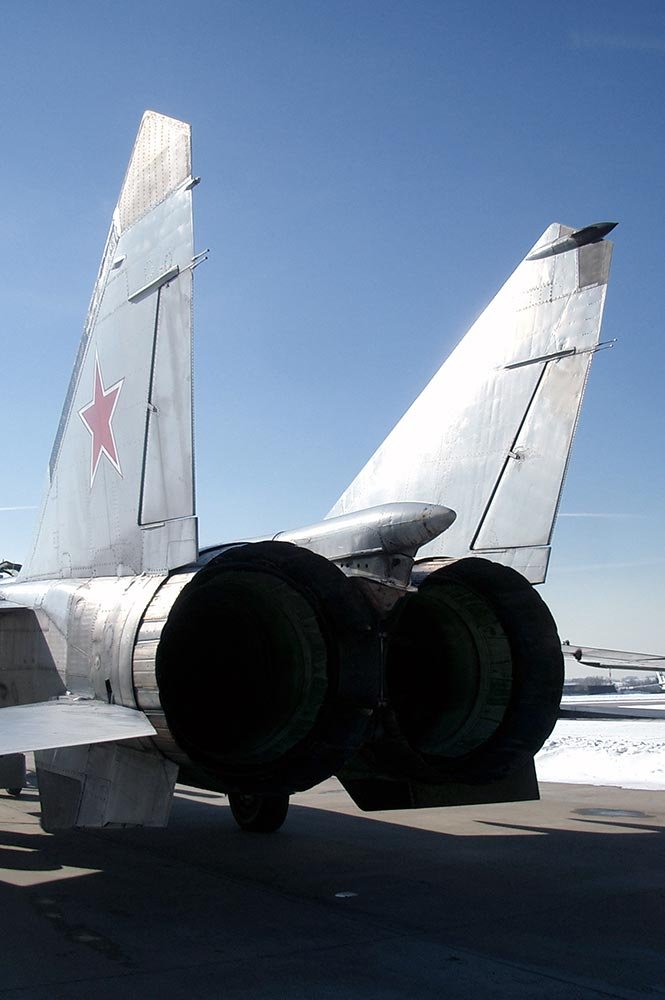 The giant Trumansky jet turbines - Ramenskoye - March 2004
The giant Trumansky jet turbines - Ramenskoye - March 2004I stood in front of the MIG, Fabrice took some photos, and I continued to watch the launch preparations. A technician came to me and put a patch in my hand. "This is the sign of our unity," he said to me in broken German. He had been stationed for 7 years in the GDR at a then Soviet MIG 25 unit, and I thanked him for the patch.
The film team was now faced with its most significant task. We had previously discussed dozens of times that some cameras would have to be installed in the cockpit and that this would take some time. When I saw Johann with a technician when they installed the cameras, I was surprised: Contrary to the assumption that I would sit in the back, I was actually sitting in front! I hadn't expected that and had to think briefly about the feeling that was spreading inside me. My pilot Sasha would sit half high behind me in his own cockpit, and we had no physical contact. "That can be cheerful," I thought. For the first time during these days a tension, albeit small, spread through me.
Standing here on the apron was synonymous with the feeling you have when you, as a cosmonaut, went in your Sokol space suit towards the elevator that took you to the top of the Soyuz rocket and then got on. Those moments I stood on the apron were entirely equivalent. A Soyuz transports a crew of maximum three persons into an orbit around the earth, to dock afterwards with the Soyuz spacecraft to the International Space Station ISS. The MIG-25 wouldn't take me so high, but to the heights described as technically feasible.
I had to think about it. 4 or 5 years ago I would not have dared to dream of taking such a step. I had completed many pieces of training in the last years, the mentally most strenuous exercise was probably the Sea Survival Training for Cosmonauts in Sochi at the Black Sea, but this flight with my 'Russian Lady' would be likely also for outsiders the most potent picture what I had done so far. I watched Johann adjusting the cameras with the ground technician. 3 cameras were permanently installed: one to the front out of the cockpit, one aimed directly at me and one to the left of the ejection seat in flight direction.
Attila discussed with me. He asked me to take another hand camera with him. I thought that would be too much for me. The cockpit was already narrow enough anyway, and I thought that I would still need my two free hands. But he didn't let go, but I tried to block this wish as long as I could.
Sergei, the right hand of my friend Igor, accompanied me around the jet and took some pictures, also behind the two large jet turbines. I looked into these openings in amazement. For a layman, only some details can be seen, but the combustion chambers of both engines are enormous!
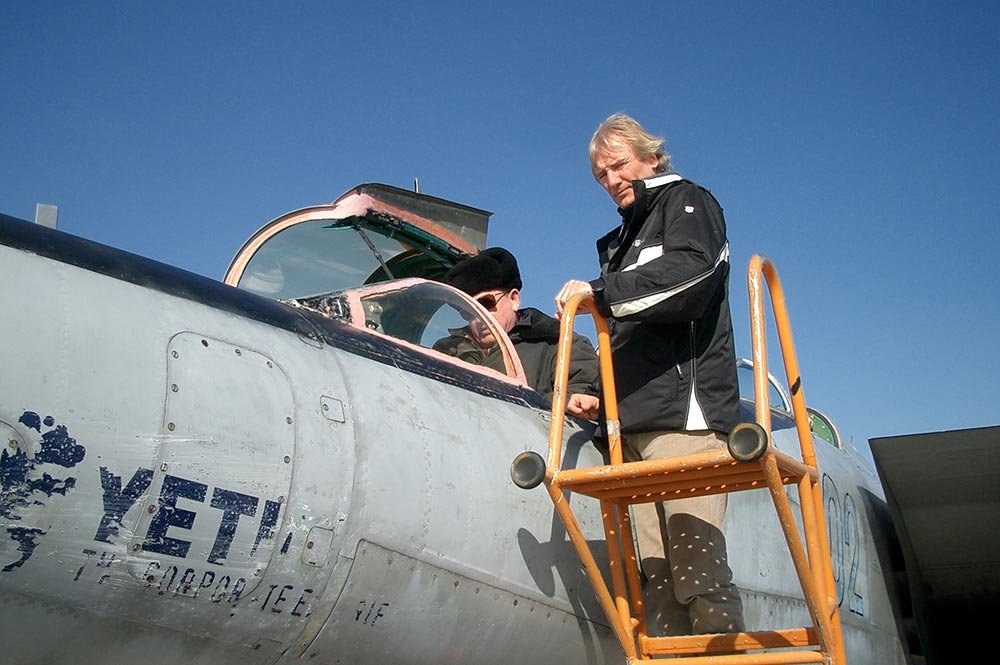 Hansi installing cameras in the cockpit - Ramenskoye - March 2004
Hansi installing cameras in the cockpit - Ramenskoye - March 2004One hour later I was tapped from behind. The ground technician, who spoke broken German, said: "Okay, now it's your turn." The time up to this moment had passed very quickly, I can't tell you what was going on in me during this hour. He led me to the yellow ladder, up the steps and half a minute later I was sitting in the cockpit. ‚Hard but hearty' I thought and tried to get all the impressions into my head. The sun shone even brighter than before, and I was strapped to my ejection seat like a guinea pig. I can tell you, one does not have much freedom in such a cockpit, although it was actually more pleasant to sit up here than some years before in the command capsule of the Soyuz spaceship, which can be called quite narrow for 3 persons.
The technician, Vasily was his name, took all the time necessary to secure me in this cockpit. Seatbelts were tightened so that I first had the feeling that I could barely breathe. A sense of tightness spread and that was the only moment during those days when I didn't feel too comfortable. Somehow, I thought that if the cockpit were still closed, it would be too narrow for me. My pulse increased, but I calmed down quickly. It was just the contact with something entirely new that I hadn't known before.
Vasily pulled here on ribbons and there on ribbons. Secured hooks here and there. I let him go. I felt safe under his care, and he gave me an absolute feeling of security. Then he disappeared from the ladder and sat alone in the cockpit for a moment, just about to take a picture when Sasha appeared next to me. I almost didn't recognise him in his pilot's outfit with a helmet.
Cockpit Briefing
Sasha asked me with a smile: "Hi Andreas. How are you?" "Thank you! I´m feeling good" I didn't precisely answer with a convincing voice, and his smile turned into a grin.
"Are you feeling scared?" he asked me, I denied in truth because I had really no feelings of fear. Sasha hit me on the shoulders and then thought he had to do a short cockpit briefing.
"Okay, now we will have a short briefing. I will show you the instruments in front of your panel and will explain the emergency procedures. After that, I will show and explain you this, please repeat the steps!" "Okay," I said, and he started explaining everything to me. He showed me the most important instruments. The altimeter, the 'Speed over Ground' meter and the Mach meter, and a display called the 'G-Force Meter'. You will probably agree with me at this moment that this is the instrument that makes you think about the flight. The loads during the trip can be up to 4.5 G.
During a Soyuz launch from the Russian Cosmodrome Baikonur in Kazakhstan, loads of up to 3.2 G can occur during takeoff, during landing usually 3.8 G. In this MIG up to 4.5 G would affect me and depend on the flight situation from now on!
Sasha patiently explained the instruments to me, and it was not too difficult to remember them. The most analytical tools can be caught at a glance. Then he led my left hand to a switch on my left side. A blue switch attracted my attention.
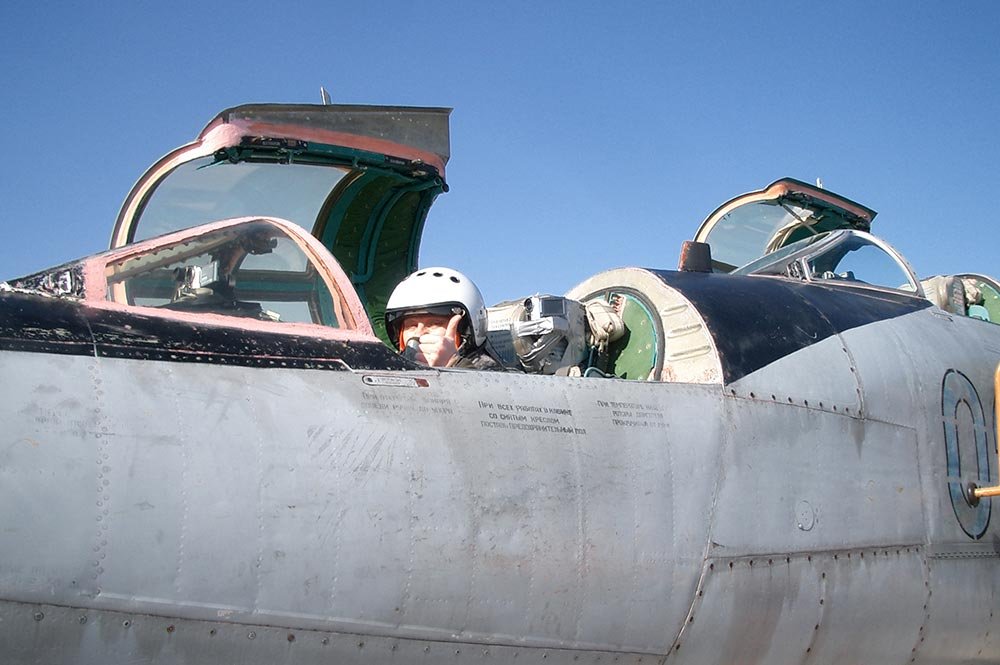 Strapped on and connected with the cockpit – Ramenskoye - March 2004
Strapped on and connected with the cockpit – Ramenskoye - March 2004"If I say to you: Switch the blue switch, you will become 100% Oxygen. If I will say that to you over the intercom, switch this switch!" I nodded my head. It seemed to be very important, and it was also clear to me when the word 'decompression' floated around in my head. He showed me the toggle switch that I could use to contact him via Intercom. And then: "If we will have an emergency ..." he stopped briefly, and I looked into his dark eyes, "... oh no, forget it. If we have an emergency situation, I will catapult our both ejection-seats out. I will arrange it. I will give you, for this reason, the command 'eject-eject-eject', push your head against your seat and wait of that, what will follow. Please, repeat!"
Then he hit me on the shoulder with his hand, and I laughed at him. Shortly after he disappeared, I took off my mydays cap and put on the fabric headgear, a piece of fabric that looks like a swim cap. Then the helmet over it and it became already 80 per cent quieter around me, the helmet isolated the sound very well. Johann stood with the big camera next to me, on the upper platform of the ladder. I still thought that this would be more daring and that he could fall from this ladder at any time. It finally went down three meters.
I fixed my oxygen mask to my helmet as I had learned and checked the seat. Folded my sun protection visor down and up again. Everything was okay. Then Johann bent from the left side into the cockpit and shouted: "Please, Andreas. Take this camera into your hands. We have three cameras permanently installed, but you never know." I thought about it for a moment. Man, I also wanted to take pictures up there. After a short back and forth I let myself be persuaded, as it should turn out afterwards, the right decision.
Johann was visibly satisfied with my consent, and I said to him that he should switch on all cameras now, which he did. The small LCD screen of the camera that was pointed at me showed me in the cockpit. At first, I was a little frightened, but then I had to laugh into myself. The Bergweiler in the cockpit of a MIG! Unbelievable!
Shortly after he had switched on the cameras, I heard the start of the turbines softened by the helmet. The machine began to vibrate, and the unimaginable power in the combustion chambers began to build up their work. My old physics teacher came to mind. Work = force x distance. Johann disappeared, and another technician, who was connected to Sasha via helmet, showed up on my left side. He pulled down the cockpit roof and locked it. He pointed then with the thumb upward and did it to him equal. At the same time, I filmed this with the hand camera, during which I felt how Sasha started the engines.
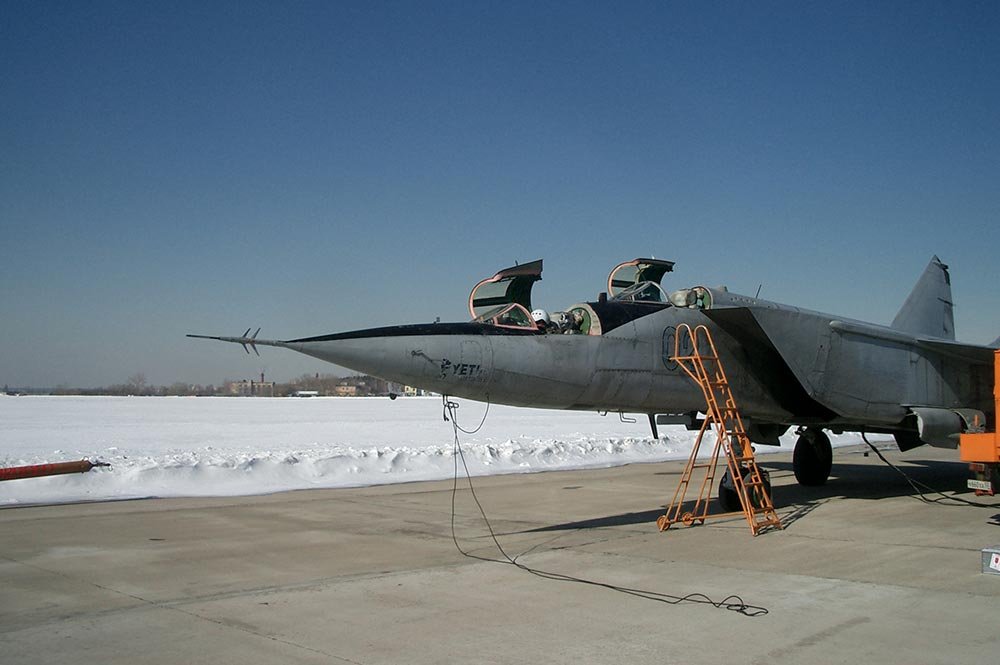 Shortly it will start - Ramenskoye - March 2004
Shortly it will start - Ramenskoye - March 2004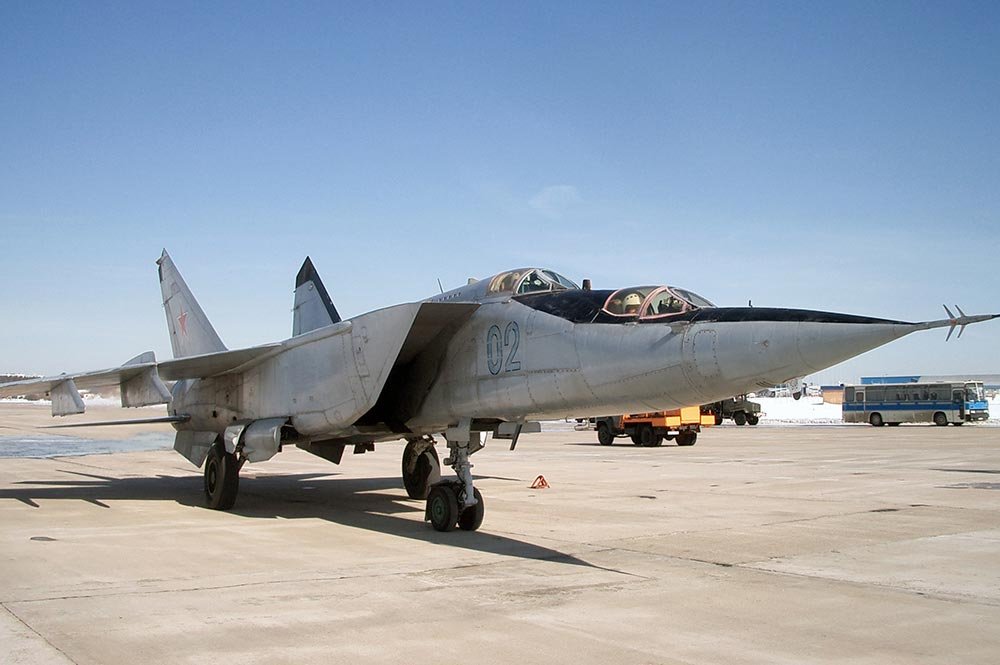 Breaks released, let's go - Ramenskoye - March 2004
Breaks released, let's go - Ramenskoye - March 2004Now I was really alone after several hours on this day. The stress with the camera team, the pressure of the medical examination, the dressing and other things disappeared from my mind. I looked through the cockpit window that completely surrounded me and saw some familiar as well as unknown faces. I saw Attila holding up his thumb and shouting something to me. What he had cried to me remains to this day his secret, since I definitely didn't understand a word.
The 5 minutes before the take-off
Shortly afterwards I could watch through the cockpit window how the ground crew moved away from the MIG. I briefly thought that they were getting into 'safety', but quickly discarded that thought. As I said, I felt safe. I was accustomed to being taken into the care of specialists. The GCTC specialists had always lulled me into safety in the past, as did the technicians of 'my' MIG 25 and Sasha, my commander and pilot. Hmmm, I thought, my commander during Sea-Survival training was also called Sasha. Sometimes there are coincidences!
Then, all of a sudden with a jerk, Sasha set the MIG in motion. Slowly she rolled along the runway. At first crawling, very slowly. I estimated once with max. 25 km/h. As in a traffic-calmed zone in Germany, I thought, and I heard the humming of the engines. Heard from the outside it probably corresponded more to a screeching, but I was not outside, but inside.
Sasha 'drove' his, and now also my Russian lady on the apron along, then made a 90-degree curve to the left, and before me, the runway spread out. The sun was behind us, and I watched the outside world. I felt like I was in a cocoon. Safe and protected. A larva in a cocoon that would soon become a butterfly.
 On the way to the runway - Ramenskoye - March 2004
On the way to the runway - Ramenskoye - March 2004Sasha 'played' with the two turbines of the engines. The sound of the engines swelled and ebbed away again. And then suddenly I saw in the small LCD screen of the camera pointing at me a sign of a battery that was crossed out. Before I could see it properly, my head disappeared from the LCD display, and the camera went off! "Great," I thought and briefly considered whether I should try to get it going myself again. But that didn't feel right to me, because Sasha told me via Intercom that we would start right away. I didn't want to interrupt his preparations for the start and didn't want to risk that he had to stop the start because of this stupid malfunction so that we would roll back again. I thought, "Okay. That's what you have the hand camera for" and thanked Johann for standing so persistently next to the cockpit and pressing the Sony Digi Cam on my eye. So I was promoted to the 'Michael Ballhaus of the MIG' in no time at all and panned the camera from left to right. Then I turned it around and put it on my right knee with the lens pointing at me and waited for the start. The world around me around appeared in a different light. The sun brightened everything outside, and it was almost a glistening light. The runway showed up in front of us, but I couldn't see the end because it was about 3 kilometres long, as I learned later.
Again, Sasha played with the turbines, and I watched the displays in the cockpit. Everything was in the green area, the weather radar before me flashed on a green screen, but there was no bad weather front within a radius of 150 kilometres to see or spy.
I breathed in and out deeply, the oxygen of my mask irrigated my lungs with every inhalation. It was a delightful feeling.
After I thought we would never fly, the MIG suddenly started to move. I heard Sasha ignite the afterburner and we took off incredibly fast. The speedometer 'over ground' indicated that the MIG accelerated to 380 kilometres within seconds and I was thinking of Michael Schumacher's Ferrari. And with the thought of Ferrari still in my head, I noticed the nose going up and within 5 seconds we were in the air, so fast that I really had to look out of the left window and saw the runway below me chasing it. A rumble was heard; briefly, Sasha retracted the landing gear, and I actually flew. Towards my goal, which I could only guess in my thoughts and dreams.
The demon calls
I filmed what it was all about. I had set my mind on delivering the best film ever made from the cockpit of a jet. I heard a beep in my intercom. Beep - beep - beep made it last, and I thought it was a glitch. I wanted to let Sasha know, but then I remembered what it was. The VFOR signal. We flew over the outer marker of the airport. So, my mind gave the all clear again, and I took my finger off the intercom button and left Sasha alone. Even though he wasn't sitting in my cockpit, I felt his presence. And that gave me an incredibly secure feeling.
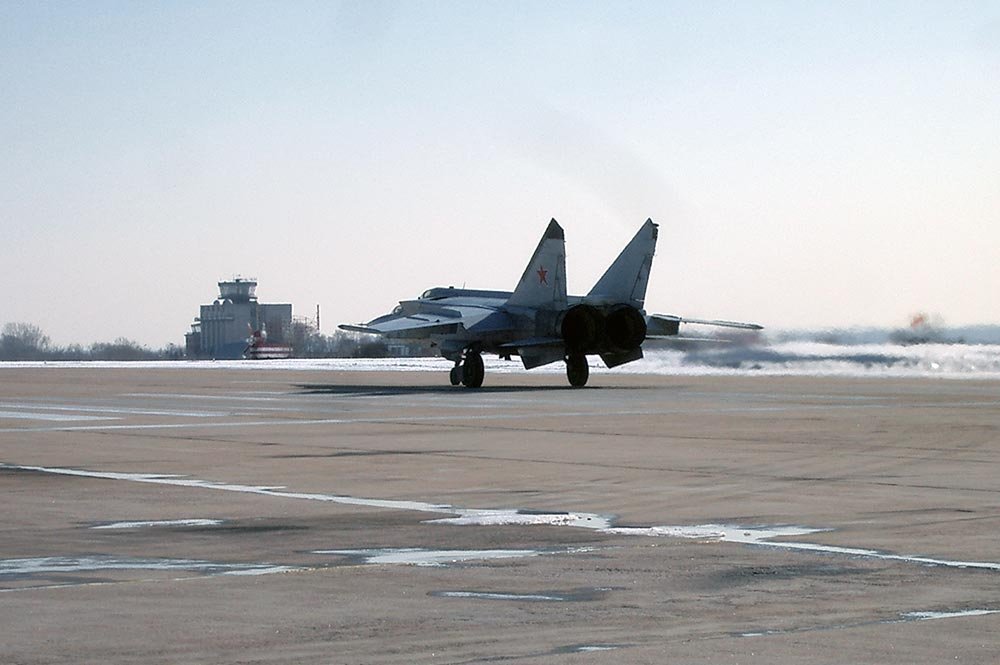 Full thrust - Ramenskoye - March 2004
Full thrust - Ramenskoye - March 2004The world below me became smaller. I looked out of the cockpit on all sides and saw the winter landscape from above, which I had only seen from the ground a few minutes before. The white became larger areas, I saw the forests surrounding the airport and other cities in the area. I thought briefly of the map section that Sasha had shown me at the briefing and could roughly imagine where we were.
The distance meter, which showed the distance from the airport, was going up steadily, and before I knew it, we were already 65 kilometres away from the airport.
Sasha flew a little left turn, and I noticed from now on that I was getting heavier. My G-Force meter hit over 2.5 G, and I thought about my ride in the centrifuge last year in September. Good that you had experienced this feeling before, I thought. I lifted up the hand camera and filmed something in the cockpit. The camera weighed about 1.2 kilos on the ground, now it had just under 3 kilos, the weight of my arm logically not included.
Sasha´s Voice sounded in my ears. "Hi, Andreas. I will inform you, that we will go now at 6.000 meters. Then, we will blast through the sound barrier. Look onto your MACH instrument!" I pointed the camera at the Mach-Meter. At the moment it was at about Mach 0.7, and it was moving slowly against the 1. Chuck Yeager came to my mind again. What was it exhausting at that time to reach the sound barrier - so say Mach 1!
Sasha let our Russian lady rise slowly but steadily, and I watched the altimeter as it stopped at just over 6,000 meters. Now it had to come, the flight through the sound barrier. To be honest, I didn't know how it would feel for us inside the jet. I thought of the demon living up there. He provoked us and hissed poison and gall.
I pointed the camera back at the Mach meter, and then I noticed briefly how a cloud that was created under a second worked its way back from the top of the MIG and then disappeared. Irritated by this event, I looked at the Mach meter, which indicates Mach 1.2. "That's it then, Andreas" - I thought. "Now you fly faster than the sound, you didn't notice anything but this 'fog' outside, and you taught the demon to fear! Ha, so the beast was defeated, but there are more demons at Mach 2 and Mach 3."
To explain: this fog was caused by the fact that we flew through more humid air layers at this moment than before. The air around us formed shock waves in front of the sound barrier, which spread at an average angle from the jet tip. As we approached the sound barrier, the air could no longer escape, and the humidity became visible. If you fly through drier layers of the atmosphere, you can't see anything with the naked eye. So, we flew there for a few minutes. Sasha steered the MIG calmly, and I looked down to the ground.
You didn't notice too much of the speed, you certainly know this feeling when you look out of the window of a scheduled plane. The earth below us moved, I tried to see clouds but definitely didn't see any. I let my gaze glide upwards. Above are also no clouds to see.
Sasha reported again via Intercom. "Andreas, now we will begin with the ascent," he said. "But, before, I will show you a role to the right!" My body was tense, but before I could think about it, he turned the MIG 360 degrees around its axis, but over the left shoulder. The world around me turned, the sky was briefly down, and then the MIG was back in its normal axillary position. "A short joke!" Sasha said. "I know in reality, where is right and left!"
I had to laugh briefly, and so we flew there, laughing in heaven, somewhere over Russia.
It's funny to explain, but I had the feeling that a voice was calling me. "Andreas! You can come now. Come up." Surely it was imagination, I felt master of my senses even if I flew with Mach 1.8 meanwhile.
"Okay. Now we will begin with ascent" I hear Sasha say and he pulled the nose of the MIG higher and put it left into a long curve. The G-Force-Meter jumped onto the 3 and stayed there for a long time.
The Ascent
Contrary to my imagination, Sasha would merely place the MIG on the propulsion beam and fly up in a straight line, he put the MIG in a left ascent curve and the G forces would settle on me. The G-Force meter approached the 4-meter mark by leaps and bounds from time to time, and I had trouble moving the camera in the cockpit. But I could regulate myself and managed to put the camera quietly on my right thigh so that its lens filmed me. I was glad I had gloves on so I could grab the hand strap well, and it didn't slip out of my hand either.
I moved my head to the left and right and noticed how the floor was moving further and further away. I looked at the Mach meter. The Mach 2 mark was already 0.2 lines behind us, so we climbed with Mach 2.2 into the blue sky over Russia.
I watched the altimeter. It rotated fast around its own axis, and I saw the numbers rising rapidly. I turned the camera on my thigh in such a way that I could roughly guess that it could detect the altimeter. The outer pointer rotated incredibly fast, a smaller pointer moved in the innermost circle, numbers appeared on display in the innermost loop. The information on the screen was in meters, not in feet. A relic from Soviet times, when Western units of measurement coming from beyond the large pond were categorically rejected. The altimeter showed 18,000 meters. So, I was already flying higher than any airliner would ever be able to. For commercial aircraft, e.g. a Boeing B 747, the end is at a maximum of 13,500 meters, then the air is no longer stable. More substantial altitudes are only reserved for aircraft that can fly faster and therefore require less lift.
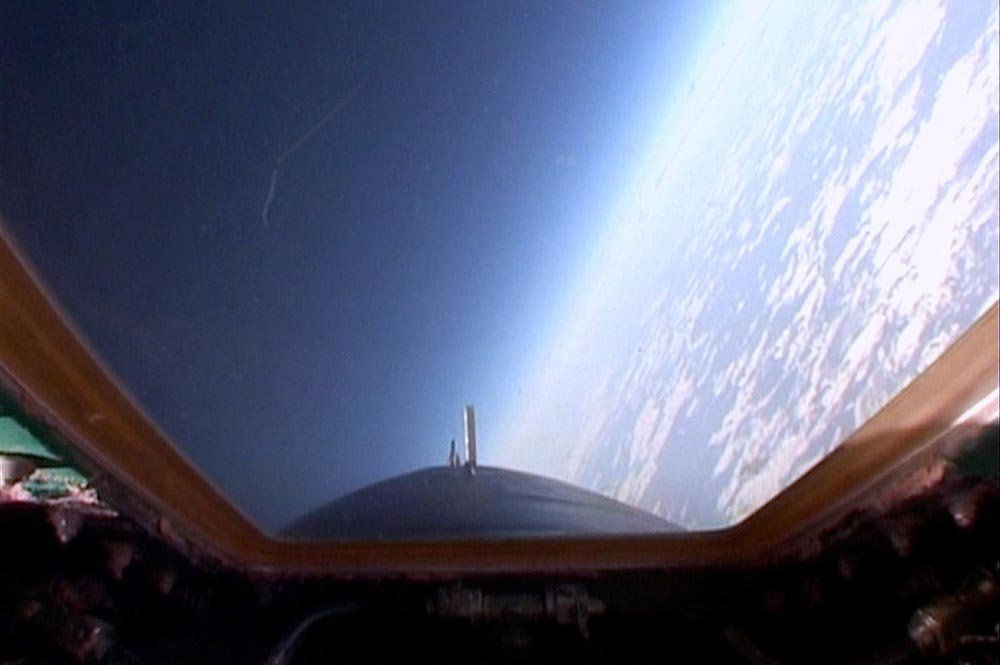 The ascent - Ramenskoye - March 2004
The ascent - Ramenskoye - March 2004The blue of the sky was still there. The earth under me shrank rapidly, and I waited for the effect that the earth's horizon rounded off more and more. This effect was already to be seen and under me were already no more details of the surface to be recognised. I looked briefly on the right side and saw a condensation trail under us.
I was terrified because I thought there would be another jet flying. Then I knew, however, and noticed that this contrail was our own, which was like a spiral behind us. So, I saw Sasha driving the MIG up like a corkscrew. The Mach meter was just before Mach 2.5.
I tried to get as much into my head as possible. The G-forces were draining on me, and I noticed the way the G-Force suit was working that was connected to the cockpit. The onboard computer pumped air into the pants to prevent the blood from sinking into the legs. I noticed the same effect on my arms. Had I not worn such a special suit at that moment, my brain would not have received enough blood supply and thus an oxygen deficiency. The result would be a 'tunnel effect', where the field of vision becomes narrower and narrower, and you think you are driving through a tunnel.
I thought of my ride in the centrifuge, and now I knew and learned for myself why space travellers fly in the direction of space while lying down. So the blood cannot collect in the legs. A space traveller does not need such a special suit, because he is pressed back on his seat. In a jet, one is exposed to faster and more abrupt manoeuvres, where the organism has no time to adjust to the new situation. After about 6 more minutes, Sasha pulled her nose back into the horizontal and horizontal position. The artificial horizon indicated that the MIG was back to normal.
"Now we are on an altitude of 25,000 meters," said Sasha via Intercom. "Welcome in the 'Edge of Space Area'".
I hadn't really noticed this. The last months almost married with this term 'Edge of Space', I was now actually at an altitude of 25 kilometres. With a car, you can get there with an average speed of 100 km/h in 15 minutes. Only I was not 'away' from my place of departure, but 'high'.
The G-forces were normal again, the Mach-meter trembled at Mach 2,6, and I filmed the face of the earth.
"Yes," I thought, "we actually live on a sphere. So Galileo was right!“
The earth appeared under me in a rich blue-white. The horizon was blue and slowly became black. I looked up and saw that the sky was actually black. Some stars sparkled, by which logically still over us real atmosphere and blue streaks were to be seen. We were in a stratospheric flight, and the only thing I could hear in my ears was the quiet buzzing of the turbines and the devices that equalised the pressure in the cockpit. I missed the words. I wanted to answer Sasha, but somehow, I couldn't get a word out. I tried to absorb what was happening around me, and then that voice came out in my head again. "Come higher," said the voice quietly. She was like a familiar acquaintance. "Come higher!
Even higher up
Sasha said to me about the intercom: "Okay, Andreas. Weather Conditions are excellent. Outside temperature is minus 87 degrees. I think we can go a little bit higher!"
Oh my god' I heard myself say. The voice had probably also reached Sasha´s ears. A short time later he put the machine back left into a curve and pulled his nose up. The G-forces shot at us again, the G-Force-Meter moved again in direction 4 and exceeded this value a little bit. So, it must have been the 4.3 G, but I didn't care at that moment. I felt good. The camera was like a stone on my right thigh, I knew it would hold that moment on Digi-Band.
The altimeter became active again. The outer pointer began to rotate forward, and the numbers continued to rise.
27,000 metres
I looked out, and the earth seemed to get smaller. Of course, this is not the case, the altitude changes, the earth is much too big to actually notice. I looked up, but I didn't have to make any dislocations because Sasha held up the nose of the MIG. I saw that the blue streaks above us sometimes condensed and sometimes disappeared. Stars sparkled and flashed.
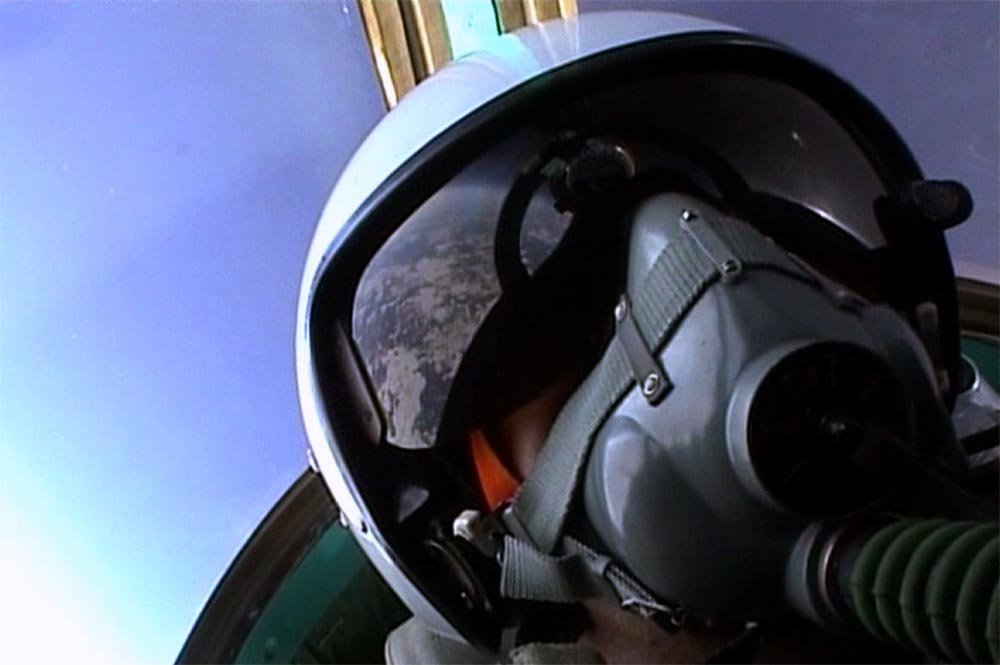 Earth reflecting in the visor - Ramenskoye - March 2004
Earth reflecting in the visor - Ramenskoye - March 2004A thousand thoughts shot through my head. The voice in my head continued to say to me: "That's right. Always higher up" and I remembered a song by Van Halen from the 80s: 'Higher and Higher and up again'.
In my thoughts, I tried to create the image of how the MIG would appear to an observer from the outside. A grey jet whose only colours were the Russian Air Force Red Star on the rudder and two small white dots representing our helmets. Somehow, I had the feeling of leaving my body and racing alongside the MIG in our ascent.
I looked at the Mach meter. At Mach 2.5 a red line was glued on, but the pointer 0.3 moved over this line, that means at Mach 2.8. There the needle got stuck, and I noticed that she actually wanted more, the Russian lady. But Sasha is a very experienced pilot, he knew exactly what he was doing and didn't endanger us in a single second.
I kept looking out the window. The earth shrank, and I noticed that I could see the surface of the planet disappearing. So, you have to see Earth when you leave your home in a spaceship from the Baikonur Cosmodrome in Kazakhstan or from Florida.
After a few minutes, Sasha pulled her nose back into normal position. The altimeter showed 29,000 meters. Exactly. Not a metre less and not a metre more.
The Mach meter showed Mach 2.8. The Russian lady, her pilot Sasha and the traveller Andreas moved away at 3,065 kilometres per hour in this minute! At that moment our kinetic energy was that of 90 coaches of 20 tons each, running towards a wall at a speed of 40 kilometres per hour at the same time and all colliding at once with a point of one centimetre.
On top of the World
More than three times as high as Mount Everest! The highest mountain in the world is 8,848 meters high, I remembered. From 6,000 meters the 'death zone' begins, the area where it becomes almost impossible for a person to breathe without an oxygen supply. And I was more than four times as high as the death zone. From here to the absolute altitude record of the MIG it was only 9,800 meters! From here to the orbit to the International Space Station it was only about 350 kilometres! Well, if that wasn't a distance.
"Welcome on the top of the world," said Sasha via Interkom. "It´s the first time, that a normal passenger since our program was started, has reached this altitude. It depends on the weather conditions, you know. In winter we have better conditions. Now, we will stay here for two minutes, then we will begin with descent!"
At first, the word "Thanks" got stuck in my throat, I was so overwhelmed. I filmed this moment with my hand camera and closed my protective visor. It was bright up here. The sun brightened the planet under me. I actually had to think that this was the planet we lived on.
Thoughts shot through my head. What my girlfriend Astrid was doing at that moment, what my friends were doing in Germany. Probably they went their regular daily business like every day and thought perhaps of me, which ploughed now with 3,000 kilometres per hour by the sky over Russia and its goal again a step closer had come.
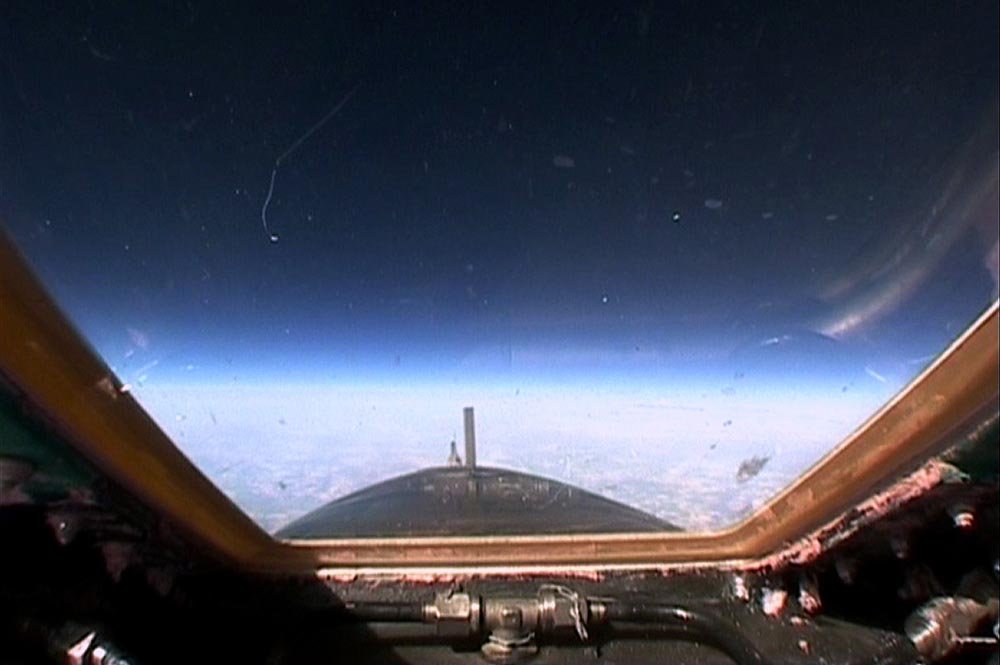 Flight of fancy - Ramenskoye - March 2004
Flight of fancy - Ramenskoye - March 2004"The earth is above me, the stars below me" is a saying of the German astronaut Rheinhold Furrer, who was in space with the Spacelab D-2 mission in the 80s. The information did not apply to my present situation, but it was related. I looked out of the window, the sky over me showed already nearly an absolute blackness.
I was sure: I had found my demon. I had not defeated him, I had only driven him away. To fly up here 'on the top of the world' was an exhilarating feeling. I had to think about how many people apart from Sasha and me would be at such heights now. And I came across only two of them, the Russian Commander Sasha Kaleri and his American colleague Michael Foale, both of whom were the crew of the ISS-8 Expedition Crew, who had been living on the International Space Station ISS as the eighth regular crew since the end of October 2003.
I thought of my friend Yuri Malenchenko, who had orbited the Earth half a year earlier as Commander of the ISS Expedition 7 crew and of my roommate in Sochi, Edward T. Lu, who had also spent 6 months together with Yuri in space. I had asked him then what would have been the best thing he had enjoyed up there in space when he flew around the Earth in a space suit. He had answered "The view" short and sweet and smiled.
At that time, I would not have dared even remotely to dream of seeing the earth from above. Well, I wasn't as high up as the crews of the spaceships and space stations, but for me, there was no feeling of 'even higher up' at that moment. I had come up very high, as technology made it possible.
At that moment, frankly, I was captivated by the feeling that I would actually be able to continue on this path to my goal of launching into orbit on top of a Russian Soyuz rocket in April 2006. In those two minutes, I was closer to my goal than ever before. All the cosmonaut pieces of training I had enjoyed so far were steps on my way here. To experience this flight, you don't have to have a dream to fly to the stars.
I am not sure if Sasha ever had this dream; unfortunately, I forgot to ask him.
Lost in thought in the highest heights, I chased up there towards my destiny.
And it is precisely the same. My fate lies somewhere out there, and the day will come when I will meet my fate. And I will absorb this feeling deeply into myself and report afterwards, so - that everyone can participate in this feeling.
As if spellbound, my gaze from the altimeter swayed out of the cockpit. All cameras worked except the one that had failed. Nobody had checked whether the cameras worked at these altitudes. I sent a quick prayer to the engineers at Sony in Japan and hoped the guys had done their job correctly.
You have the Control!
Sasha ripped me out of my thoughts. "Now we begin with the descent!“ I heard in my ear, and it decreased the speed. He cut me abruptly from my thousands of thoughts. The Mach meter quickly fell below the Mach 2.0 mark, and the sound I could hear in the cockpit became a different one. Sasha lowered the nose of the MIG downwards, and the horizon of the Earth began to disappear from my perspective and shifted towards the cabin ceiling.
Now I saw the blue of the earth from a completely different perspective, and I raced towards my home planet again. Still, no cloud was to be seen, I was not sure however whether I could distinguish the snow surfaces actually from clouds from this height. The Russian lady spoke to me and said: "Well, Andreas, have I promised you too much? I've brought you up here, and you can be sure: I'll take you home safe and sound." I wondered how you could get to your home airport from this height.
The descent I made was comparable to the descent manoeuvre of the space shuttle. The shuttle reduces speed in swivel tracks. From 28,000 kilometres per hour to almost 600 within 12 minutes. I had to think of the crew of the Columbia mission that crashed in February 2003. The accident had happened at much higher altitudes than the one I was currently in. But it was the same feeling for me as if one would return from a mission from the stars. Sasha steered the MIG back to the home base in the right and left turns.
I couldn't see where the home base would be, but of course, I knew that Sasha was an absolutely experienced pilot and test pilot. He would bring our Russian lady and me safely back to the home base.
I watched the altimeter. As fast as it had risen only minutes before, it fell off now. Within minutes we had reached "normal" heights of 12,000 metres when a crack in my headphone again announced Sasha after he had pulled his nose up a bit.
"Okay, Andreas. Now, you have the Control!"
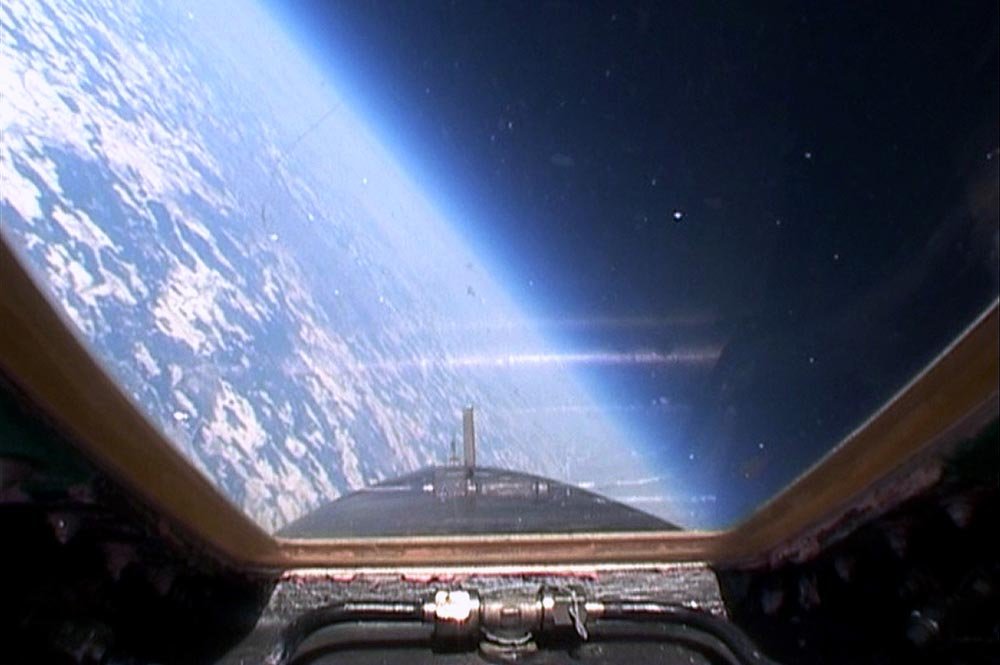 The descent - Ramenskoye - March 2004
The descent - Ramenskoye - March 2004My heart almost stopped. Had I misheard myself? Did he really tell me that I had control of the MIG 25?
I wanted to ask if it was a joke, but I dismissed the question and looked down at my feet standing in the rudder pedals. I pushed my left foot a little to the left, and the MIG 25 responded immediately with its rudder and began a slight pan to the left.
"No, Andreas. Use the Stick! That´s easier" Sasha said, and I swallowed again. Now I had a problem. In my right hand, I had the Sony-Cam. So, I had to control the MIG with my left hand. Okay, I thought. It's the heart side so nothing can go wrong.
I clasped the flight stick with my left hand and pressed it gently to the left. The MIG reacted immediately, and I noticed that we were making a left turn.
"Be patient, Andreas. Not over 30 Degrees" I heard Sasha say and immediately pulled the stick to the right side. A right turn followed, and the MIG tilted gently to the right side. It was just incredible. Now I not only flew 'in' a MIG 25, but I actually flew it. Well, I was always sure because Sasha was sitting behind me and could positively intervene in an emergency, and I didn't exaggerate and didn't make capers. I wanted to return to Earth safe and sound, so I didn't strain the nerves of the Russian lady or the nerves of my commander and pilot.
When I had flown a few left and right turns, I pulled the stick towards me. The jet reacted immediately and flew a little up again. I watched the altimeter. It was really like that. I steered the jet up again. Then I pushed the stick forward, and the nose lowered again. "Perfect, Andreas," I heard Sasha say in the intercom. "You have the flight-blood in your veins!
If I hadn't had the oxygen mask in front of my face, I would have loudly rushed out. However, the mask prevented a laughing fit, and I already noticed that he meant this statement seriously. I thought well of myself, perhaps in another life!
For two or three minutes I had control of the machine, then Sasha took over. I'm going back to the jet. In the meantime, we had fallen to 6,000 meters, the surface of the ground had taken on familiar contours again. In a long distance, I could see the airport and the runway, which seemed to be infinite.
Sasha said: "Andreas! In front of you! You see the airport?"
"Yes, I see!" I replied.
"Okay, please land!"
He couldn't be, and I laughed so hard that my oxygen mask stood out from my face. Of course, he wasn't serious! And we both laughed for a while. The runway was getting closer and closer, and I heard myself talking to the team a few hours ago as we discussed with Sasha that Attila needed a scene showing the jet from the outside in the air. So now Sasha thundered over the runway at a speed of almost 650 kilometres at 60 meters, flew 4 kilometres straight out, switched on the afterburner again and put the MIG behind the control tower in an entire left-leaning position. My old acquaintance, the G-Force Meter jumped over the 4-meter mark yet, but I didn't care at that moment.
Sasha made an elegant 180-degree turn, racing over the treetops and buildings of the airport. After 10 kilometres, he steered the plane 180 degrees and headed for the runway.
Shortly before touching down I heard this "beep-beep-beep" again. VFOR reported back that we had flown over the marking points in front of the runway and were approaching our touchdown point.
Sasha drove out the landing gear, which was only a little-noticed by me. The ground was approaching, the rear wheels were landing on the runway, the tip was tilting more towards the ground, and after a few seconds, we were stuck with all the wheels on the concrete surface of the runway.
So, the earth had me back! And thanks to Sasha and the Russian lady, not in pieces!
Return
The speed decreased, and it became a smooth ride on the taxiway. I was surprised that it was so well sprung, and you could hardly feel anything. I had seen big jets that seemed more married to the runway than I had in my life. The MIG drove straight to the point where we had started 40 minutes or so earlier.
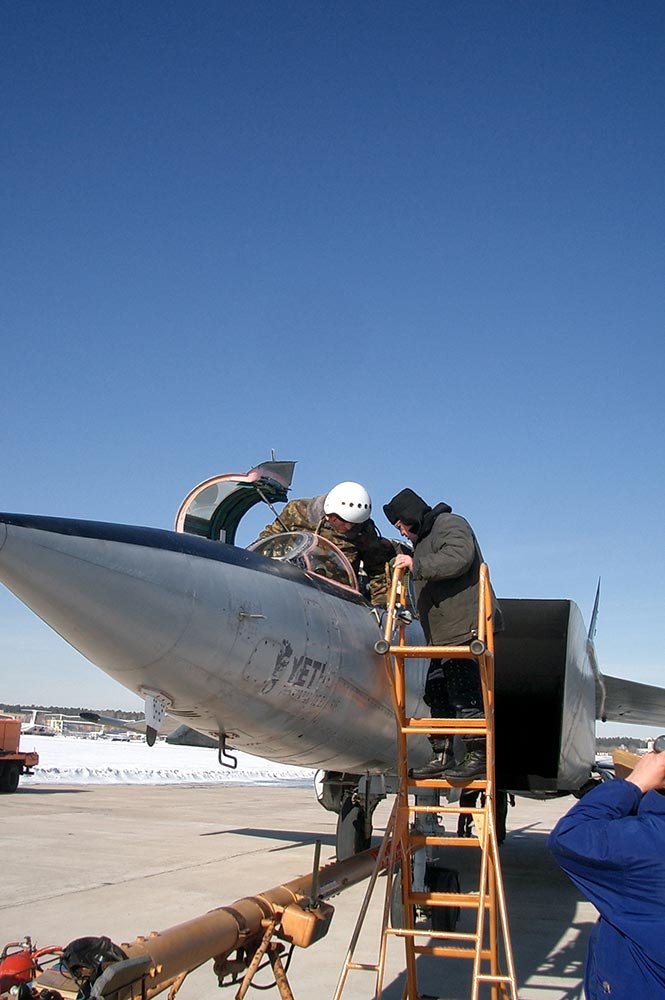 Nearby solid ground under the feet - Ramenskoye - March 2004
Nearby solid ground under the feet - Ramenskoye - March 2004I noticed that the apron with our bus and ground staff was getting closer and closer, lines and somehow things that had grown together with the surroundings became our bus and the team. Sasha steered the MIG to the right, I could see Attila and Florian through the cockpit, who recorded my arrival with small hand cameras. I thought about where Johann would be, but I could imagine that he had been standing far outside next to the runway with the big Digi-Beta to capture the overflight as well as the landing in close-up on tape.
After 100 meters Sasha again made a U-turn, and he brought the plane to the point exactly where we had rolled off. The turbines died and the noise that had accompanied me for the last 40 minutes stopped.
To be honest, I didn't really notice much of what was happening around me. The yellow ladder was pushed back up, and very quickly my cockpit was opened. Cold air surrounded my face, where it could not be captured by the helmet and the oxygen mask. I let the oxygen mask fall from the helmet, with a trained handler and faster than expected I stood upright in the cockpit. And that without trembling. Later I was told that I had only grinned.
I descended the ladder, and after a few meters, I had solid ground under my feet again. But I didn't miss to stroke the outer skin of the MIG with my right hand when descending from the cockpit and to say thank you. "Thank you for this ride", I said, if not loudly. She replied in thought, "Thank you for this ride, you were a pleasant passenger. See you next time, Andreas".
As soon as I had moved a few meters, Sasha was already standing next to me. I embraced him and thanked him. "That was, as you have said before, the greatest experience of my life! Thank you very much for this!" His dark eyes reflected satisfaction, and he briefly said "You are always welcome back! "
Immediately Attila and Flo stormed me, and I had to play live in front of the camera what I would feel now. To this day I can't tell you what I said. I have to wait for the moment myself until I will see the complete film recordings before they can be seen in PRO 7 in April or May of this year. Of course, I will inform you of this date here, so that you can follow this flight not only here on the Internet with pictures and my stories, but also on TV, in particular with the photos, which I took part under the load of 4.5 G with the hand camera.
 Nearby solid ground under the feet - Ramenskoye - March 2004
Nearby solid ground under the feet - Ramenskoye - March 2004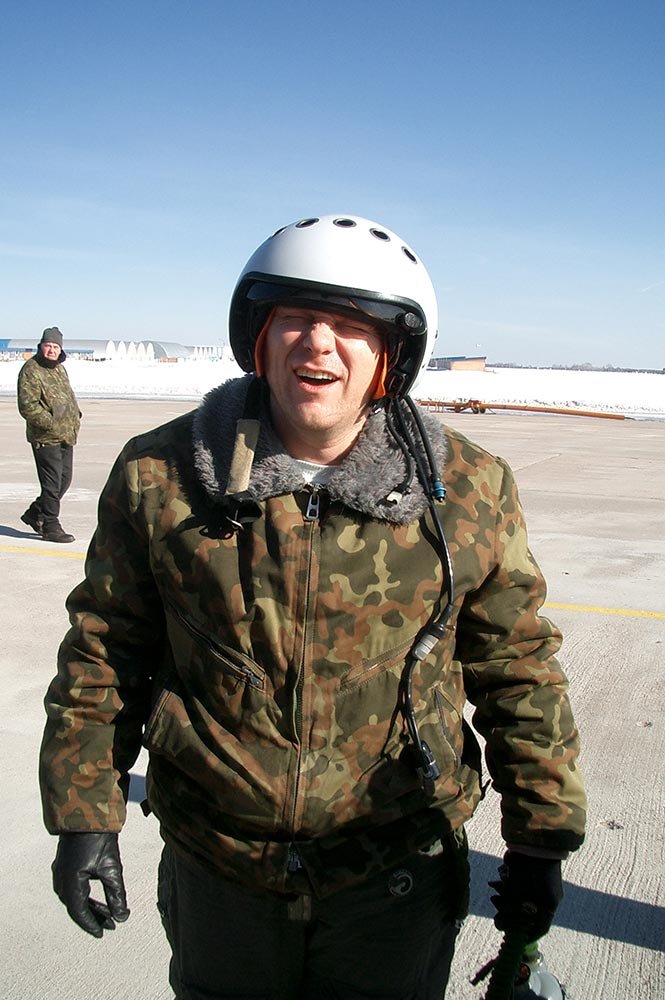 Mind lost on altitude - Ramenskoye - March 2004
Mind lost on altitude - Ramenskoye - March 2004For a moment I felt like 'Lord of the world' and 'Lord of feelings'. I would have liked to have turned around and climbed back into the cockpit with Sasha to do the flight again.
Surely that was not possible at that moment. But maybe at some point.
Epilogue
I experienced another world in 45 minutes. An unforgettable experience, if not the most extraordinary of all. Many wanted to know what it was like after my return. I could not give any information. This flight experience belongs to one of the lessons of the last years. Certainly: every training I have done so far for the way to the stars was essential and a step in the right direction. Every practice had its fascination and was also very important to be able to judge me.
 The crew (standing from left) Attila Teri - Sergei Prokopovich - Fabrice Schmidt - Hansi Goldfuß-Falke - Florian Ruppert - (front) Igor Rudyaev - Vasily Popov
The crew (standing from left) Attila Teri - Sergei Prokopovich - Fabrice Schmidt - Hansi Goldfuß-Falke - Florian Ruppert - (front) Igor Rudyaev - Vasily Popov7 years ago, I built a website for fun, which dealt with the topic of space travel and space. Without this idea, I would not have met the people who helped me on my way. Without team and network thoughts such a step is not possible. Many have accompanied me on this way up to here, some have left me, and others I will still move. That is part of this journey. I have even been able to win others over. What happens next is already revealed: In July 2004 I will go to the 'Desert Survival Training for Cosmonauts' in the desert of Kazakhstan to face a new challenge, survival in the desert. You may now say that this is probably not as exciting as the MIG flight. I can only tell you from my own experience: every step that takes me to the stars is an exciting step in itself. My world has changed a bit since this experience. My daily routines are still in standard orbit, and I don't have the feeling that I have to 'take off'.
One day I will take off and fly to the stars, orbit the earth for 8 - 11 days and reach the heights I thought of during the MIG 25 flight. The difference of this flight was 350 kilometres to the ISS. But I can imagine and realise it.
Maybe after you have read this diary of the "Edge of Space Flights" a new idea is developing in your mind. And as you may have already experienced, I am always looking for new things and progress to have.
Until the next adventure!
By Andreas P. Bergweiler (D) - MIG 25 'Edge of Space Flight' on March 11, 2004
Andreas P. Bergweiler
MIG-25 'Edge of Space Flight' March, 11, 2004
March 2004

